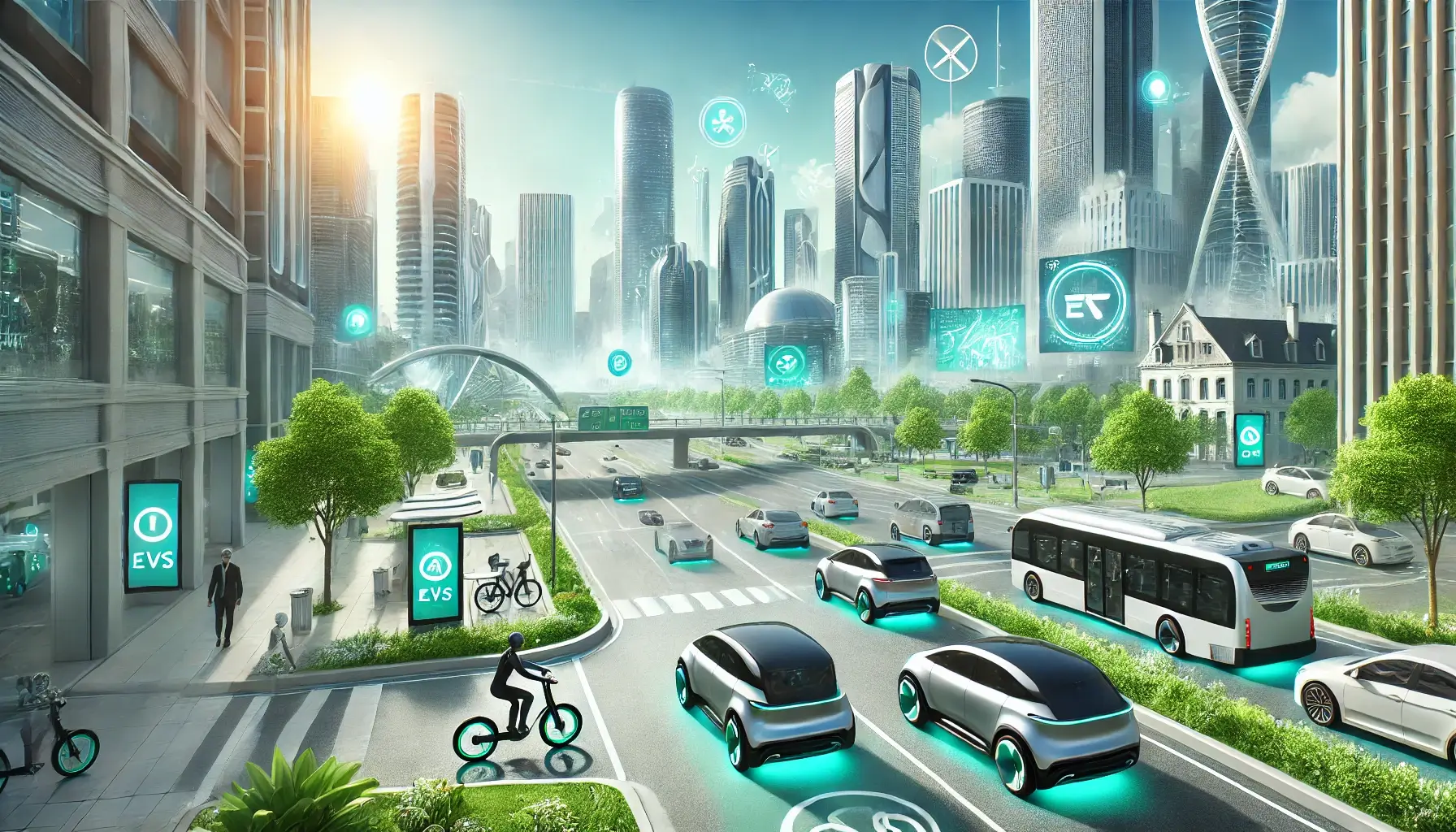-
How Digital Nomads Are Redefining Work and Lifestyle 🌍💻
Mar 06, 2025 | 38 Comments -
How Artificial Intelligence is Transforming Healthcare 🏥🤖
Mar 06, 2025 | 0 Comments -
How Cryptocurrency is Reshaping the Global Economy 💰🌍
Mar 06, 2025 | 0 Comments -
How to Build a Strong Personal Brand: Stand Out & Grow Your Influence 🚀📢
Mar 02, 2025 | 0 Comments -
The Power of AI in Business: How Artificial Intelligence is Transforming Industries 🚀🤖
Mar 02, 2025 | 0 Comments -
How Smart Homes Are Changing the Way We Live 🏡🔋
Mar 02, 2025 | 0 Comments -
How Electric Vehicles Are Revolutionizing Transportation 🚗⚡
Mar 02, 2025 | 0 Comments -
The Future of Renewable Energy: How Green Technology is Changing the World 🌍⚡
Mar 02, 2025 | 0 Comments

How Electric Vehicles Are Revolutionizing Transportation 🚗⚡
🚗⚡ Electric vehicles (EVs) are **changing the way we drive, reduce emissions, and power transportation**. With advancements in battery technology, charging infrastructure, and government incentives, EVs are becoming **more accessible and affordable** than ever. But what makes EVs better than gas-powered cars, and why are more people making the switch? Let’s explore how electric vehicles are **revolutionizing the automotive industry**. 🔥
1. Why Electric Vehicles Are Gaining Popularity 🌍
More drivers are choosing EVs because they are **cleaner, more efficient, and cheaper to maintain**. Here’s why: ✅
1.1 Environmental Benefits 🌱
- 🌍 **Zero emissions** – EVs don’t produce carbon pollution like gas-powered cars.
- 🌿 **Less air pollution** – Reduces smog and improves urban air quality.
- 💨 **Lower carbon footprint** – Renewable energy charging makes EVs even greener.
1.2 Cost Savings & Efficiency 💰
- 🔋 **Cheaper fuel** – Electricity costs less than gasoline.
- 🛠️ **Low maintenance** – Fewer moving parts mean fewer repairs.
- ⚡ **Regenerative braking** – Converts energy back into power, improving efficiency.
2. How Electric Vehicles Work ⚡
Unlike traditional gas-powered cars, EVs **run entirely on electricity**, eliminating the need for fossil fuels. 🚀
2.1 Key Components of an Electric Vehicle 🔧
- 🔋 **Battery Pack** – Stores energy and powers the electric motor.
- ⚙️ **Electric Motor** – Converts electricity into motion.
- 🔌 **Charging Port** – Allows the vehicle to recharge from an electrical source.
2.2 Types of Electric Vehicles 🚗
- 🔌 **Battery Electric Vehicles (BEVs)** – Fully electric with no gas engine (e.g., Tesla Model 3).
- 🔋 **Plug-in Hybrid Electric Vehicles (PHEVs)** – Combine a battery with a gasoline engine (e.g., Toyota Prius Prime).
- ⚡ **Hybrid Electric Vehicles (HEVs)** – Use both gas and electricity, but can’t be plugged in (e.g., Honda Accord Hybrid).
3. The Expansion of EV Charging Infrastructure 🔋
More charging stations are being built to support **the growing number of EVs** on the road. 📈
3.1 Types of EV Chargers 🏁
- 🔌 **Level 1 Charging** – Uses a standard 120V outlet (slow charging).
- ⚡ **Level 2 Charging** – 240V stations found in homes and businesses (faster).
- 🚀 **DC Fast Charging** – Rapid charging stations for long-distance travel.
3.2 Wireless Charging & Smart Grids 🚗
- 📡 **Wireless EV charging** is being tested for hands-free recharging.
- 🔋 **Smart grids** balance power use and prevent energy overload.
- 🌞 **Solar-powered charging stations** are making EVs even more sustainable.
4. How EVs Are Disrupting the Auto Industry 🚘
Automakers are shifting to **electric models**, investing billions into new technology. 🔥
4.1 Traditional Car Brands Are Going Electric ⚡
- 🚗 **Ford** – Launched the Mustang Mach-E and F-150 Lightning.
- 🚙 **General Motors** – Plans to go fully electric by 2035.
- 🔋 **Volkswagen** – Investing in EVs with its ID. series.
4.2 The Rise of EV Startups 🚀
New companies are challenging legacy automakers with **cutting-edge technology**. 🌎
- ⚡ **Tesla** – Leading the EV market with high-performance models.
- 🚙 **Rivian** – Specializing in electric trucks and SUVs.
- 🌍 **Lucid Motors** – Competing with luxury EVs.
5. Challenges & Solutions for EV Adoption 🔄
Despite the benefits, EVs still face **challenges in adoption**. Here’s how they are being addressed. ✅
5.1 Battery Costs & Range Anxiety 🔋
Many drivers worry about **how far an EV can go on a single charge**. Solutions include:
- 📈 **Longer-range batteries** – New EVs can travel 300+ miles per charge.
- 🔬 **Battery recycling & innovations** – Reducing costs and waste.
5.2 Charging Availability ⛽
Expanding charging networks will make EVs **more convenient**. 🚀
- 🏙️ **More urban charging stations** for city drivers.
- 🚗 **Highway fast-charging** for long-distance trips.
6. Government Incentives & Policies for EVs 🌎
Many countries are supporting **the transition to electric mobility**. ✅
6.1 Tax Credits & Subsidies 💰
- 🇺🇸 **Up to $7,500 in federal tax credits** for EV buyers in the U.S.
- 🇪🇺 **European subsidies** make EVs more affordable.
- 🇨🇳 **China’s EV incentives** are driving mass adoption.
6.2 Plans to Phase Out Gas Cars ⛔
- 🏙️ **Bans on gas cars by 2035** in multiple countries.
- 📈 **Investments in clean energy** for greener transportation.
Final Thoughts: The Shift to Electric Vehicles is Here 🚗⚡
Electric vehicles are **reshaping transportation**, making travel **cleaner, cheaper, and more efficient**. With automakers, governments, and consumers embracing EVs, the transition away from gas-powered cars is accelerating. 🚀
Would you buy an electric car? Share your thoughts in the comments! 💬⚡
0 comments
No comments yet. Be the first to comment!
Your comment